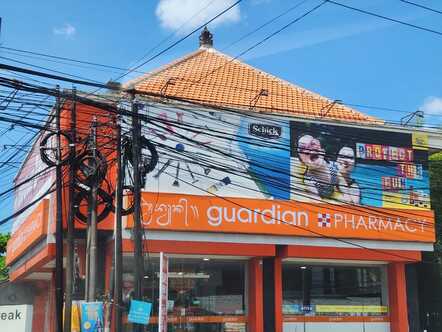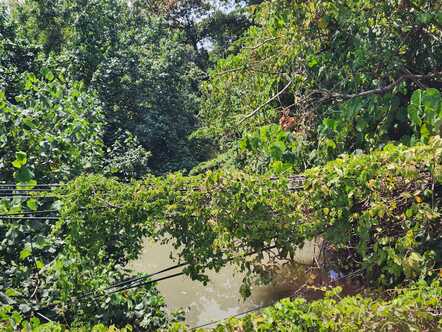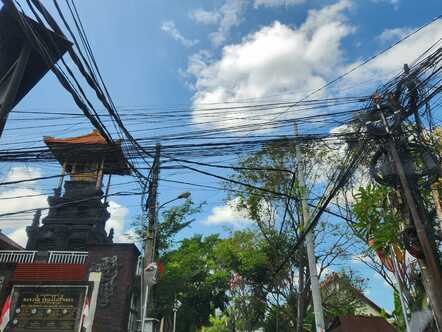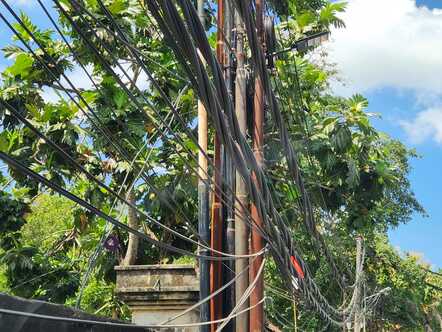Aerial cable tangles are still being strung up, but carriers are slowly burying the problem
'Sky spaghetti' remains on the menu for Asian carriers, and tourists
Unruly telecom cables may seem an unlikely tourist attraction, but in the Vietnamese town of Hoi An you can buy t-shirts that celebrate the thick snarls and loops of wire dangling from many of the nation's telegraph poles.
In Bangkok, similar messes are celebrated by tourists and locals alike, who snap selfies with the hanging wires.
How did these messes come about?
"This is basically mismanaged," network and security professional Yasir Nawaz told The Reg when showed a picture of intersecting wires on poles containing many loops.
"Usually when ordering above ground cables you specify the size. It could be any fixed size. Once it is shipped, it is up to implementation to get it to look nice. In the photo, the cable is longer than required. With so many cables of incorrect length, it gets messy, and it makes it difficult to tell them apart," explained Nawaz.
The networking pro said many technicians leave the wires on utility poles because the installation may not be permanent and tidying cable messes ahead of imminent replacement is considered an unnecessary effort.
Extra cable also helps carriers because troubleshooting is easier when there's a bit of slack to work with. But after cabling is confirmed to work correctly, and to be in the right location, if no one is being paid to leave a tidy site, messes remain in place.
But are these above ground mixes of telephone, broadband, cable TV, and electricity cables really problematic – or just an eyesore?
"Both," said Nawaz. "Aerial cables face dangers associated with thunderstorms and things touching it."
In extreme cases a pole can even collapse under the load of excess cable. The tropical climate in many of Asia's most populous nations makes rot a real threat.
"The long run solution is to go underground. It's just safer," Nawaz said.
In 2016, the city of Bangkok decided to do just that: move its power, cable and telecommunication lines underground. It budgeted around 50 billion baht, which today equates to $1.4 billion, to install the 127 kilometers of cable.
The move came after a little bit of misguided shaming from Bill Gates, who mistook communication cables for power cables. Nonetheless, attention from the billionnaire techie was enough to drive the cables underground.
The Thai city of Pattaya, about 150 kilometers south of Bangkok, has also recently completed an effort to move lines on seven out of nine routes covering 20 kilometers underground. That project has an $87.6 million budget.
Bangkok's Metropolitan Electricity Authority (MEA) has reportedly said laying wires underground costs ten times more than hanging them on poles.
"Overhead cabling is less costly than underground cabling. It is easy and quick to install and it is also easy to repair because it is out in the open," New Delhi-based vice president of research at Gartner, Amresh Nandan, told The Register.
Nandan pointed out that aerial electricity cables have higher carrying capacity than underground alternatives. However, he's still a major advocate of moving these systems underground – or at least a hybrid approach of below ground when possible.
"No doubt when you when you put them underground, safety is definitely ensured. Not just safety – even environmental factors, because these cables do create electromagnetic noise that can affect birds or other signals," said Nandan.
Planning for underground builds is hard. Establishing underground "rights of way" for new cables with the appropriate civic body is seldom simple. And that's on the rare occasion only one body signs off on the project.
More often, such projects require coordination between municipal corporations, civic bodies, and utility companies. All can have a say in the applicable regulations, construction processes and operational procedures. Law enforcement needs to be on board – and strict – to provide a level of accountability.
Nandan said cable messes aren't unique to any nation, but they are more common in emerging markets where the agencies that are responsible for managing policies are yet to develop a certain level of planning and forecasting maturity.
In areas where corruption is high, such messes are even more likely, according to Nandan. In those areas, law enforcement may be convinced to turn a blind eye, especially if – surprise! – some loose cash finds its way into their possession.
But despite such barriers, fixing cable messes is only going to become more important over time. With more floods and extreme weather events likely, above ground cables will face more outages and present more danger. Nandan said managing such systems should be a priority for civic bodies in developing their climate change responses.
"It's a very important topic, we need to pay more attention to it," warned Nandan.
He took a no excuses approach to the matter, pointing out the technology exists to address challenges – even in very adverse geographical conditions.
"We even have cables in the sea!" he pointed out. ®




 Biting the hand that feeds IT
Biting the hand that feeds IT